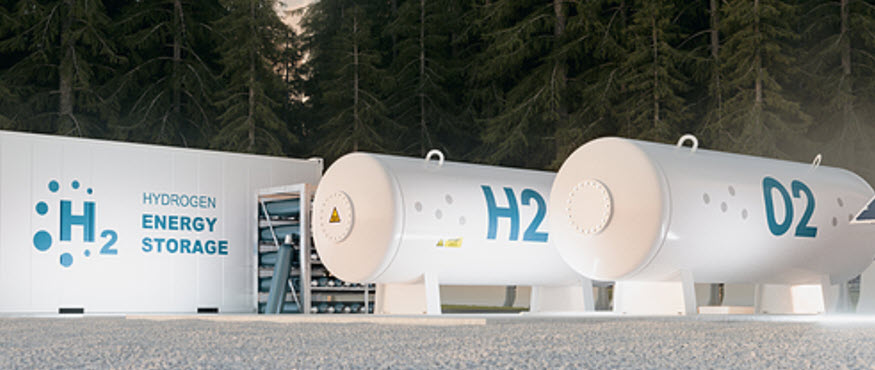What is electrolysis and how does this process result in H2 production?
Hydrogen fuel is widely viewed as a form of renewable energy that will play a central role in the global transition to renewable energy and away from fossil fuels. That said, this leaves many asking how is hydrogen made along with some other questions such as:
renewable energy and away from fossil fuels. That said, this leaves many asking how is hydrogen made along with some other questions such as:
- What is hydrogen gas?
- How do you make hydrogen?
- How does a hydrogen fuel cell work?
What is H2 and how is it used as a fuel?
H2, that is, hydrogen fuel, is a molecule consisting of two hydrogen atoms. It is very flammable and can be used as a fuel that doesn’t produce any greenhouse gas emissions such as carbon. This makes it highly appealing as a renewable energy source in the global effort to mitigate climate change.
H2 can be produced using several different methods. Today’s most commonly used methods are natural gas reforming and electrolysis, though solar-driven and biological processes are used to a substantially lesser extent.
In the pursuit of a non-carbon emitting method of production, water electrolysis is often viewed as the cleanest option. This is particularly true when the hydrogen electrolysis is powered by a renewable source of electricity such as solar or wind. In that case, the product is referred to as green hydrogen.
What is electrolysis and how does it produce hydrogen fuel?
Electrolysis is a process that is viewed as one of the greenest forms of hydrogen fuel production, particularly when powered by renewable electricity. This process uses the electricity for splitting water into its hydrogen and oxygen atoms. The electrolysis reaction takes place in an electrolyzer unit. An electrolyzer consists of an anode and a cathode separated by an electrolyte. The way the electrolyzer functions depends on the type of electrolyte material used. The most common types of electrolyzer are currently:
- Polymer electrolyte membrane (PEM) electrolyzers
- Alkaline electrolyzers
- Solid oxide electrolyzers
The majority of green hydrogen fuel production projects are focused on PEM electrolyzers of various sizes and designs.
How is H2 gas stored and distributed?
Once electricity has been used to produce hydrogen fuel, the gas must then be stored so that it can be used when needed. It can be stored as either a gas or as liquid H2 (LH2). As a gas, it typically requires high-pressure tanks (350–700 bar [5,000–10,000 psi] tank pressure).

It can be transported by road in cryogenic liquid tanker trucks, in gaseous tube trailers, or by rail or barge. It can also be transported directly from the production point to its destination for use via pipeline such as those currently in place in many locations with an existing natural gas pipeline infrastructure. In fact, tests are currently underway by utilities and municipalities around the world for using existing natural gas pipelines to transport hydrogen fuel as a replacement for natural gas for zero-emission home heating.
In the case of fuel cell electric vehicles (FCEVs), distribution is quite similar to that of gasoline or diesel. Drivers can head into a filling station, connect the dispenser to the vehicle and refill the tanks. It takes about 3 to 5 minutes to fully refuel a car; about the same amount of time as it would take to refuel a gasoline-powered car.

Why is hydrogen fuel so appealing?
Hydrogen fuel, particularly green H2, is an appealing form of renewable energy for a number of reasons. It is highly abundant as it is a component of water – it can even be produced with sea water – and produces only water as its emissions when it is used. H2 has a spectrum of potential applications and can be produced without emissions when the electrolysis is powered by solar or wind energy. FCEVs have a longer range than battery electric vehicles, and refilling takes substantially less time than recharging. H2 is quiet to use and is odorless, and safety advances have improved exponentially in recent years.
While there remain a number of challenges to overcome before hydrogen fuel can be used as a mainstream fuel for home heating, marine shipping, aircraft, trains, buses, heavy-duty vehicles, tractor trailers and personal vehicles, many countries, companies and organizations believe it is only a matter of time before the technology is in place for affordable, practical and greenhouse gas emission free renewable energy.
We looked for a video that really goes into detail on electrolysis to help as well…
About Us: Here at HFN we explore answers to questions like what is a fuel cell, what is green hydrogen and what is the use of hydrogen. On this page we answer how hydrogen fuel cell is made but make sure to sign up for our free ebook that explains about what a hydrogen community is and more on solving key hurdles like efficient hydrogen storage and infrastructure. For more information about our ebook – https://www.hydrogenfuelnews.com/hydrogen-fuel-cell-ebook/

 With over 15 years of reporting hydrogen news, we are your premier source for the latest updates and insights in hydrogen and renewable energy.
With over 15 years of reporting hydrogen news, we are your premier source for the latest updates and insights in hydrogen and renewable energy.